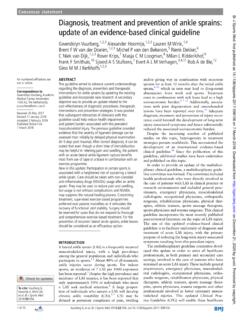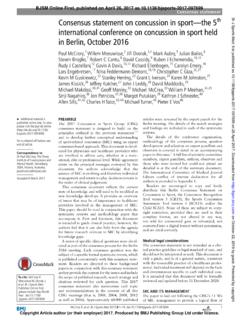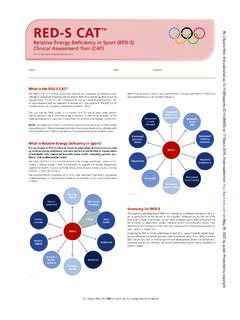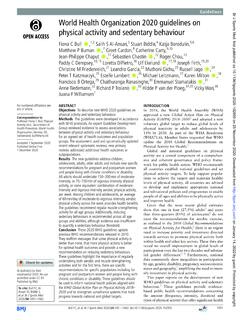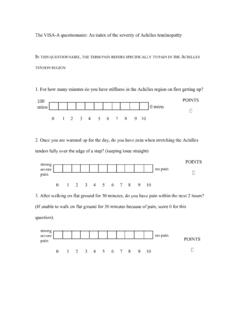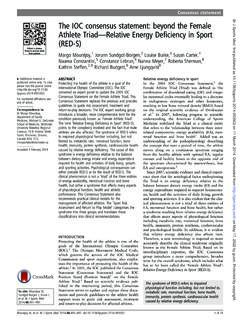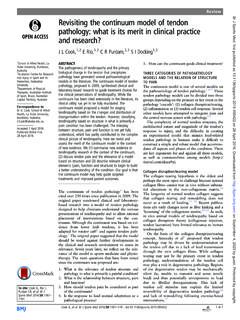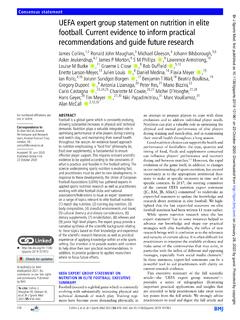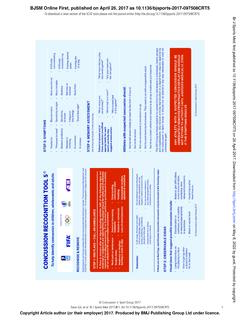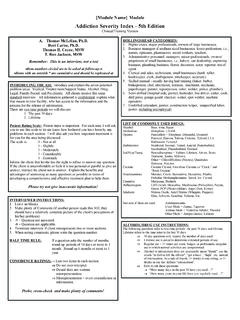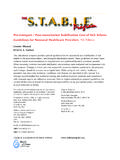Transcription of Sport concussion assessment tool - 5th edition
1 BJSM Online First, published on April 26, 2017 as To download a clean version of the SCAT tools please visit the journal online ( ). Br J Sports Med: first published as on 26 April 2017. Downloaded from on 7 August 2018 by guest. Protected by copyright. SCAT5 . Sport concussion assessment TOOL 5th edition . DEVELOPED BY THE concussion IN Sport GROUP. FOR USE BY MEDICAL PROFESSIONALS ONLY. supported by Patient details Name: DOB: Address: ID number: Examiner: Date of Injury: Time: WHAT IS THE SCAT5? Key points The SCAT5 is a standardized tool for evaluating concussions Any athlete with suspected concussion should be REMOVED.
2 Designed for use by physicians and licensed healthcare FROM PLAY, medically assessed and monitored for professionals1. The SCAT5 cannot be performed correctly deterioration. No athlete diagnosed with concussion in less than 10 minutes. should be returned to play on the day of injury. If an athlete is suspected of having a concussion and If you are not a physician or licensed healthcare professional, medical personnel are not immediately available, the please use the concussion Recognition Tool 5 (CRT5). The athlete should be referred to a medical facility for urgent SCAT5 is to be used for evaluating athletes aged 13 years assessment .
3 And older. For children aged 12 years or younger, please use the Child SCAT5. Athletes with suspected concussion should not drink alcohol, use recreational drugs and should not drive a motor Preseason SCAT5 baseline testing can be useful for vehicle until cleared to do so by a medical professional. interpreting post-injury test scores, but is not required for that instructions for use of the SCAT5 are concussion signs and symptoms evolve over time and it provided on page 7. Please read through these instructions is important to consider repeat evaluation in the assess- carefully before testing the athlete.
4 Brief verbal instructions ment of concussion . for each test are given in italics. The only equipment required The diagnosis of a concussion is a clinical judgment, for the tester is a watch or timer. made by a medical professional. The SCAT5 should NOT. be used by itself to make, or exclude, the diagnosis of This tool may be freely copied in its current form for dis- concussion . An athlete may have a concussion even if tribution to individuals, teams, groups and organizations. their SCAT5 is normal . It should not be altered in any way, re-branded or sold for commercial gain.
5 Any revision, translation or reproduction Remember: in a digital form requires specific approval by the Concus- sion in Sport Group. The basic principles of first aid (danger, response, airway, breathing, circulation) should be followed. Recognise and Remove Do not attempt to move the athlete (other than that required A head impact by either a direct blow or indirect transmission for airway management) unless trained to do so. of force can be associated with a serious and potentially fatal assessment for a spinal cord injury is a critical part of the brain injury.
6 If there are significant concerns, including any initial on-field assessment . of the red flags listed in Box 1, then activation of emergency procedures and urgent transport to the nearest hospital Do not remove a helmet or any other equipment unless should be arranged. trained to do so safely. concussion in Sport Group 2017. SCAT5. Davis GA, et al. Br J Sports Med 2017;0:1 8. in Sport Group 2017 1 1. Copyright Article author (or their employer) 2017. Produced by BMJ Publishing Group Ltd under licence. Br J Sports Med: first published as on 26 April 2017.
7 Downloaded from on 7 August 2018 by guest. Protected by copyright. 1. Name: IMMEDIATE OR ON-FIELD assessment DOB: Address: The following elements should be assessed for all athletes who are suspected of having a concussion prior to proceeding to the ID number: neurocognitive assessment and ideally should be done on-field after Examiner: the first first aid / emergency care priorities are completed. Date: If any of the Red Flags or observable signs are noted after a direct or indirect blow to the head, the athlete should be immediately and safely removed from participation and evaluated by a physician or licensed healthcare professional.
8 Consideration of transportation to a medical facility should be at STEP 4: EXAMINATION. the discretion of the physician or licensed healthcare professional. GLASGOW COMA SCALE (GCS)3. The GCS is important as a standard measure for all patients and can Time of assessment be done serially if necessary in the event of deterioration in conscious state. The Maddocks questions and cervical spine exam are critical Date of assessment steps of the immediate assessment ; however, these do not need to be done serially. Best eye response (E). No eye opening 1 1 1.
9 STEP 1: RED FLAGS. Eye opening in response to pain 2 2 2. Eye opening to speech 3 3 3. RED FLAGS: Eyes opening spontaneously 4 4 4. Neck pain or Seizure or convulsion Best verbal response (V). tenderness Loss of consciousness No verbal response 1 1 1. Double vision Deteriorating Incomprehensible sounds 2 2 2. Weakness or tingling/ conscious state Inappropriate words 3 3 3. burning in arms or legs Vomiting Confused 4 4 4. Severe or increasing Increasingly restless, Oriented 5 5 5. headache agitated or combative Best motor response (M). No motor response 1 1 1.
10 Extension to pain 2 2 2. STEP 2: OBSERVABLE SIGNS. Abnormal flexion to pain 3 3 3. Witnessed Observed on Video Flexion / Withdrawal to pain 4 4 4. Lying motionless on the playing surface Y N. Localizes to pain 5 5 5. Balance / gait difficulties / motor incoordination: stumbling, slow / Obeys commands 6 6 6. Y N. laboured movements Glasgow Coma score (E + V + M). Disorientation or confusion, or an inability to respond appropriately Y N. to questions Blank or vacant look Y N. CERVICAL SPINE assessment . Facial injury after head trauma Y N. Does the athlete report that their neck is pain free at rest?
